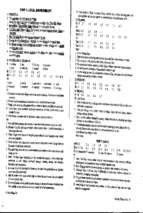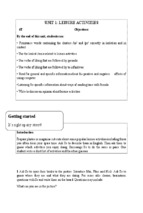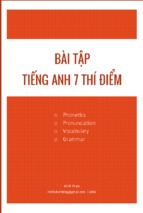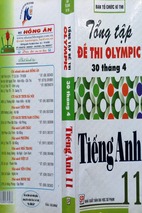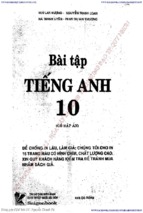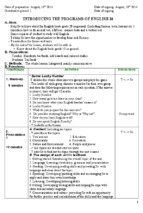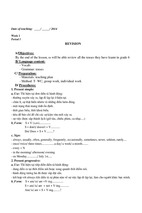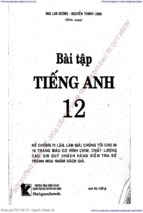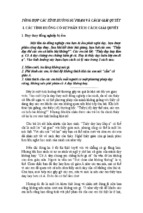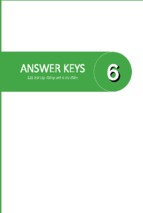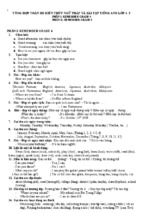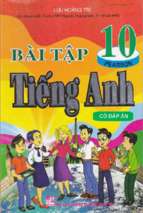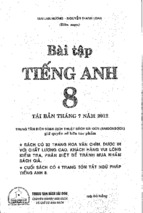CHUYÊN ĐỀ HỘI THẢO
MÔN: TIẾNG ANH
PROBLEMS OF FINAL ENGLISH
ACHIEVEMENT TESTS FOR NON-MAJOR
STUDENTS OF GROUP 11 AT MY SCHOOL AND
SOME SUGGESTIONS FOR CHANGES
N¨m häc 2015 - 2016
TABLE OF CONTENTS
PẢRT I - INTRODUCTION…………………………………………………............
1
I.1. Reason for choosing the topic……………………………………………………
1
I.2. Scope of the research……………………………………………………………..
1
1.3: Aims of the research……………………………………………………………..
2
I.4. Methods of the research………………………………………………………….
2
I.5. Organization of the research…………………………………………………….
2
PART II – LITERATURE REVIEW……………………………………………….
3
II.1. Language testing……………………………………...........................................
3
II.1.1. Definitions of language testing………………………………………………...
3
II.1.2. Purposes of language testing………………………………………...................
3
II.1.3. Relationship between language testing and language teaching and learning
…………………………………………………………………………………………..
5
II.2. Achievement tests………………………………………………………………..
5
II. 3. Major qualities of a good test.…………………………………………………
7
II.3.1. Validity………………………………………………………………………….
8
II.3.2. Reliability……………………………………………………………………….
9
II.3.3. Discriminability………………………………………………………………...
11
PART III – THE METHODOLOGY………………………………………………..
13
III.1. The overview of the English teaching, learning and testing at My
13
school………………………………………………………………
III.1.1. Students and their background………………………………………………
13
III.1.2. The English teaching staff……………………………………………………
13
III.1.3. Testing situation………………………………………………………………
14
III.1.4. The syllabus…………………………………………………………………...
14
III.1.5. The final achievement test for non-major students of group 11…………….
16
III.2. The methodology……………………………………………………………….
17
III.2.1. Data collection instruments…………………………………………………..
17
III.2.2. Participants……………………………………………………………………
17
III.2.3. Data analysis………………………………………………………………….
17
III.2.3.1. Reliability coefficient…………………………………………………….................
17
III.2.3.2. Item discriminability and difficulty………………………………………………...
18
III.3. Discussion……………………………………………………………………….
20
III.3.1. Reliability…………………………………………...........................................
20
III.3.2. Validity………………………………………………………….......................
20
PART IV – CONCLUSION………………………………………………………….
22
IV.1. Summary of the minor research…………………...………………………….
22
IV.2. Suggestions……………………………………………………………………...
22
IV.3. Limitations and suggestions for further researches………………………….
24
REFERENCES
LIST OF TABLES AND FIGURES
Table 1: Discriminability………………………………………………………………...12
Table 2: Syllabus for non-major students of group 11………………………………...14
Table 3: Specification of the final test for non-major students of group 11………….16
( Semester II / School year: 2014 – 2015)
Table 4 Frequency distribution in the final achievement test…………………………17
PẢRT I - INTRODUCTION
I.1. Reason for choosing the topic
Language play an important role in every field of social life as they help people to
communicate well: conveying messages and receiving messages from others. Among
languages in the world, the most popular one is, perhaps, English because for a long time it
has been considered a means of international communication for those who want to get
access to the modern world. That is the reason why the number of learners of English is
increasing rapidly throughout the world. In Vietnam nowadays, English is a compulsory
subject in the curriculum of most secondary and high schools and even many primary ones.
There is no doubt that testing is an essential part of language teaching and learning. From
the results of the tests, depending on different kinds of tests, with different purposes, the
teacher infers a certain level of language acquisition of students in such different areas of
grammar, vocabulary, pronunciation, or speaking, listening, writing and reading. However,
at the level of high schools in Vietnam, it is more important to calculate the number of
students who pass English tests than to evaluate how well students acquire and use what
they have been taught as well as at which level of English they are standing, which says
nothing about the validity, reliability or discrimination of the tests. Additionally, there have
been a lot of complaints about the English achievement tests at high schools in terms of
their content and structure.
For that matter, I wish to undertake this minor research entitled “ Problems of final
English achievement tests for non – major students of group 11 at my school and some
suggestions for changes” with the hope to figure out how reliable and valid those tests are.
Also, it is aimed at improving the current testing; therefore, enhance the quality of teaching
and learning English among teachers and students at my school,
I.2. Scope of the research
The main focus of this minor research is the reliability as well as validity of final
English achievement tests for non – major students of group 11 at my school. Apart from
it, the paper includes some analyzed statistic data of currently used tests and some findings
are withdrawn. Based on the findings, practical suggestions to improve the tests are
proposed.
1
I.3. Aims of the research
This minor research aims at:
Investigating the reliability and validity of some final English achievement tests for
non-major students of group 11 at my school basing on the statistic data collected
from the achievement test results of those students.
Identifying the problems of the tests.
Giving some suggestions for the test improvement.
I.4. Methods of the research
In order to carry out this minor research, I firstly gathered as well as searched for
some reference materials on the Internet, analyzed and synthesized them to have an overall
background knowledge of the topic concerned. Then, I collected data from a final test for
non-major students of group 11 at my school and some students’ results. Employing some
formulas is the next step to interpret the data and present suggested findings.
I.5. Organization of the research
There are four main parts in this minor research:
Part I is the introduction presenting the rationale, the scope, the aims, the method
and the organization of the research.
Part II consists of the literature review concerning issues of language testing,
qualities of a good test and achievement tests.
Part III indicates the results as well as the findings from the data collected.
Part IV includes conclusion and practical implications for improving the tests.
Also, some recommendations for further research on the topic are proposed.
2
PART II – LITERATURE REVIEW
In this part, an overview of the theoretical background for the research is discussed.
Firstly,
the
term “language
testing” including
the
definitions,
purposes
and
the
relationships between language testing, teaching as well as learning is established. Then
achievement tests are explored and an overview of characteristics of a good test focusing
on reliability and validity is examined.
II.1. Language testing
II.1.1. Definitions of language testing
Testing is an important part of every teaching and learning experience. It
contributes a lot to the teaching and learning process. Also, it is a form of measurement.
According to Carroll (1968:46), a test is “a procedure designed to elicit certain behavior
from which one can make inferences about certain characteristics of an individual”. Allen
(1947:313) defines test as “ a measuring device which we use when we want to compare an
individual with other individuals who belong to the same group.” This definition
emphasizes more on sense of competition through tests among students than their
performance
In addition, Ibe (1981:1) and Read (1983) share the same idea when pointing out
that a test is “ a sample of behavior under the control of specified conditions aiming at
providing a basis for performing judgments.” Similarly, Heaton (1988:5) considers tests as
means of assessing the students’ performance and motivating them. Many students are
eager to take tests at the end of the semester to know how much knowledge they have.
In brief, the above – mentioned definitions indicate that testing is a very good way
to measure the quality of education, evaluate learners’ ability as well as their skills. It is of
great use to both language teaching and learning.
II.1.2. Purposes of language testing
Testing is certainly not the only way to assess students, but there are many good
reasons for including a test in your language course.
A test can give the teacher valuable information about where the students are in
their learning and can affect what the teacher will cover next. They will help a
teacher to decide if her teaching has been effective and help to highlight what needs
to be reviewed. Testing can be as much an assessment of the teaching as the
learning
3
Tests can give students a sense of accomplishment as well as information about
what they know and what they need to review.
Tests can also have a positive effect in that they encourage students to review
material covered on the course.
Tests are also a learning opportunity after they have been taken. The feedback after
a test can be invaluable in helping a student to understand something she couldn't
do during the test. Thus the test is a review in itself.
According to Mc Namara (2000), language testing has three main purposes. Firstly, it
is a key to succeed because language testing is a decisive way in recruitment. Secondly, it
contributes to educational goals. And thirdly, it plays an important part in the field of
research. To do research on a language, researchers need to evaluate standard tests or to
design tests in that language.
Hughes (1989:7) illustrates four different purposes of language testing as follows:
Measuring language proficiency regardless of any language courses that candidates
may have followed.
Discovering how far students have achieved the objectives of a course of study.
Diagnosing students’ strengths and weaknesses to identify what they know and
what they do not know.
Assisting placement of students by identifying the stage or part of a teaching
program most appropriate to their ability.
Besides, Henning (1987:1 – 2 – 3) points out six major purposes of language testing
presented as follows:
Diagnosis and Feedback: to find out strengths and weaknesses of the learners.
Screening and Selection: to decide who should be allowed to participate in a
particular program of study
Placement: to identify a particular performance level of the student and to place
him in a particular program of study
Program Evaluation: to provide information about the effectiveness of programs of
study
Providing Research Criteria: to provide a standard of judgment in a variety of other
research contexts based on language test scores.
4
Assessment of Attitudes and Sociopsychological Differences: to determine the
nature, direction, and intensity of attitudes related to language acquisition.
II.1.3. Relationship between language testing and language teaching and learning
According to Heaton (1988:5), teaching and testing are somewhat so interwoven
and independent that they can’t be torn apart. He says:” Both testing and teaching are so
closely interrelated that it is virtually impossible to work in either field without being
constantly concerned with the other.” Hughes ( 1989:2) summarizes the relationship as “
The proper relationship between teaching and testing is surely that of partnership,” He
illustrates this relationship using the term “backwash”, the effect of testing on teaching as
well as learning. If the testing leaves good effects on teaching, the backwash is beneficial.
However, if the test content does not go with the objectives of the course, the backwash is
harmful, which leads to problems of teaching.
In terms of learning, testing is a tool to “pinpoint strengths and weaknesses in the
leaning abilities of the students.” (Henning, 1987 :1). In other words, with tests, learners
can find out how much knowledge they have acquired, what their problems are and,
therefore, adjust their learning and explore more effective methods to improve their results.
As Heaton (1988:5) notes “ Tests may be constructed primarily as devices to reinforce
learning and motivate the students or as a means of assessing the students’ performance in
the language.”
In conclusion, testing and teaching - learning process have a very close
relationship. Testing can have good effect on teaching and learning and vice versa. It helps
teachers as well as learners to clarify what the learners really need to know. As a result, a
good test is a valuable device for learners to revise their knowledge and teachers to
improve their teaching methods.
II.2. Achievement tests
Achievement tests play an indispensable role in the school programs, especially in
evaluating students’ acquired language knowledge and skills during the course, and they
are used at different school levels.
Achievement tests are designed to measure learners’ ability in a language
regardless of any training they may have had in that language. It is based on the
specification of what candidates have to be able to do in the language in order to be
considered proficient. Proficient means having sufficient command of the language for a
5
particular purpose. For example to discover if someone can function successfully as a
United Nations translator. Other examples are Cambridge examinations or Oxford EFL
examinations. The purpose of theses tests is to show whether candidates have reached a
certain standard with respect to certain specified abilities. They are directly related to
language courses. In other words, they are to establish how successful individual students,
group of students or the courses themselves have been in achieving objectives.
Another approach is that Achievement tests are associated with the process of
instruc-tion. Examples would be: end of course tests, portfolio assess-ments, or
observational procedures for recording progress on the basis of classroom work and
participation. Achievement tests accumulate evidence during, or at the end of, a course of
study inorder to see whether and where progress has been made in terms of the goals of
learning. Achievement tests should support the teaching to which they relate. Writers have
been critical of the use of multiple choice standardized tests for this purpose, saying that
they have a negative effect on classrooms as teachers teach to the test, and that there is
often a mismatch between the test and the curriculum, for example where the latter
emphasizes performance. An achievement test may be self-enclosed in the sense that it
may not bear any direct relationship to language use in the world outside the classroom (it
may focus on knowledge of particular points of grammar or vocabulary, for example). This
will not be the case if the syllabus is itself concerned with the outside world, as the test will
then automatically reflect that reality in the process of reflecting the syllabus. More
commonly though, achievement tests are more easily able to be innovative, and to reflect
progressive aspects of the curriculum, and are associated with some of the most interesting
new developments in language
assessment in the movement known as alternative
assessment. This approach stresses the need for assessment to be integrated with the goals
of the curriculum and to have a constructive relationship with teaching and learning.
Standardized tests are seen as too often having a negative, restricting influence on
progressive teaching. Instead, for example, learners may be encouraged to share in the
responsibility for assessment,
and
be trained
to
evaluate their own capacities in
performance in a range of settings in a process known as self-assessment.
Based on the above – mentioned approaches, many writers share the same ideas of
what an achievement test is. According to Davies (1999:2), “achievement refers to the
mastery of what has been learnt, what has been taught or what is in the syllabus,
6
textbooks, materials, etc. An achievement test, therefore, is an instrument designed to
measure what a person has learnt within or up to a given time”. Also, Hughes (1989: 10)
and Brown (1994: 259) points out that “An achievement test is related directly to
classroom lessons, units or even total curriculum. Achievement tests are limited to a
particular material covered in a curriculum within a particular time frame.”
Achievement tests consist of two main kinds: final achievement tests and progress
achievement tests.
Final achievement tests are those administered at the end of the course of the study.
They may be written and administered by ministries of education, official
examining boards, or by members of teaching institutions. The content of a final
achievement test should be based directly on a detailed course syllabus and its long
term competency or on the books and other materials used. This has been referred
to as the syllabus-content approach. This approach is advantageous in the way that
the test only contains what the students have actually learnt, and thus can be
considered a fair test. However, the negative side is that the results of the tests can
be very misleading once the syllabus is badly designed or the books and other
materials are badly chosen. Another approach is to design the test content directly
on the objectives of the course. This is much preferable and provides more accurate
information about individual and group achievement, and is likely to promote a
more beneficial backwash effect on teaching.
Progress achievement tests are tests which are intended to measure the progress that
learners are making. As a result, these tests should be related closely to objectives
of the syllabus and make clear progression toward the final achievement tests. Such
kind of tests will accommodate with what has been taught as long as the syllabus
and teaching methods are appropriate to the objectives. In the other way round, it is
the examiners’ responsibility to make changes.
II. 3. Major qualities of a good test.
Before making a test, test designers often ask themselves many questions such as:
How do we design a test that is a true indicator of students’ communicative ability? How
do we know that it is a good one? And so on. To have a good test, it is necessary for test
designers to considerate three major qualities: validity, reliability and discriminability,
which are considered to be critical and sometimes referred to as essential measurement
7
qualities. According to Bachman (1996:19), these characteristics provide the major
justification for using test scores as a basis for making inferences or decisions.
II.3.1. Validity
Validity is the quality that most affects the value of a test and the most critical factor to
be judged in the total program of language testing. Heaton (1988: 159) defines validity as
“the extent to which it measures what it is supposed to measure”. As a result, a test with
high validity has items closely linked to the test’s intended focus. On the other hand, a test
with poor validity does not measure the content and competencies it ought to. Additionally,
Black & William (1998:26) points out “validity is the extent to which inferences made from
assessment results are appropriate, meaningful, and useful in terms of the purpose of the
assessment”. In somewhat more technical terms, McMillan (2007: 11), who is widely
recognized as an expert on validity, defines validity as “an integrated evaluative judgment
of the degree to which empirical evidence and theoretical rationale support the adequacy
and appropriateness of inferences and actions based on test scores and other modes of
assessment”. It might be inferred from such definitions the following attributes of validity.
A valid test:
measures exactly what it proposes to measure
does not measure irrelevant or "contaminating" variables
relies as much as possible on empirical evidence (performance)
involves performance that samples the test's criterion (objective)
offers useful, meaningful information about a test-taker's ability
is supported by a theoretical rationale or argument
Sako ( 1983: 24) presents five primary validity concepts:
Content validity: refers to the connections between the test items and the subjectrelated tasks. The test should evaluate only the content related to the field of study
in a manner sufficiently representative, relevant, and comprehensible.
Construct validity: implies using the construct (concepts, ideas, notions) in
accordance to the state of the art in the field. Construct validity seeks agreement
between updated subject-matter theories and the specific measuring components of
the test. For example, a test of intelligence nowadays must include measures of
multiple intelligences, rather than just logical-mathematical and linguistic ability
measures.
8
Concurrent validity: uses statistical methods of correlation to other measures.
Examinees who are known to be either masters or non-masters on the content
measured are identified before the test is administered. Once the tests have been
scored, the relationship between the examinees’ status as either masters or nonmasters and their performance (i.e., pass or fail) is estimated based on the test.
Predictive validity: estimates the relationship of test scores to an examinee's future
performance as a master or non-master. Predictive validity considers the question,
"How well does the test predict examinees' future status as masters or nonmasters?". For this type of validity, the correlation that is computed is based on the
test results and the examinee’s later performance. This type of validity is especially
useful for test purposes such as selection or admissions.
Face validity: is determined by a review of the items and not through the use of
statistical analyses. Unlike content validity, face validity is not investigated through
formal procedures. Instead, anyone who looks over the test, including examinees,
may develop an informal opinion as to whether or not the test is measuring what it
is supposed to measure.
In short, validity is the “must” for testers to take into considerations when they
construct a language test.
II.3.2. Reliability
Reliability is a necessary quality of any good test. It is the extent to which an
experiment, test or any measuring procedure shows the same result on repeated trials.
According to Sako (1983:28), the reliability of a language test is concerned with the degree
to which it can be trusted to produce the same result upon repeated administration to the
same individual, or to give consistent information about the value of a learning variable
being measured. Henning (1987:10) claims that all tests are subject to inaccuracies. The
ultimate scores gained by the test takers only provide approximate estimations of their true
abilities. A test on which the scores obtained are generally similar when it is administered
to the same students with the same ability, but at a different time is said to be a reliable
one.
Also, Bachman (1990:24) considers test reliability as “a quality of test score”. It
means that if a student gets two different scores on the same test on two different days, the
test doesn’t yield similar results, and the score cannot be considered reliable indicator of
9
the individual’s ability. Thus, the principle of reliability might be capsulated as follows. A
reliable test:
is consistent in its conditions across two or more administrations
gives clear directions for scoring/evaluation
has uniform rubrics for scoring/evaluation
lends itself to consistent application of those rubrics by the scorer
contains items/tasks that are unambiguous to the test-taker
The most common learner-related issue in reliability is caused by temporary illness,
fatigue, a"bad day," anxiety, and other physical or psychological factors, which may make
an observed scoredeviate from one's "true" score. Also included in this category are such
factors as a test-taker's test-wiseness, or strategies for efficient test-taking (McMillan,
2007, p. 80). For the classroom teacher, student-related unreliability may at first blush
seem to be a factor beyond control. We're accustomed to simply expecting some students
to be anxious or overly nervous tothe point that they "choke" in a test administration
context.
But the experience of many teachers suggests otherwise. Human error,
subjectivity, and bias may enter into the scoring process. Inter-rater reliabilityoccurs when
two or more scorers yield consistent scores of the same test. Failure to achieve intrarater reliability could stem from lack of adherence to scoring criteria, inexperience,
inattention, or even preconceived biases. Popham (2006) provided some helpful hints on
how to ensure inter-rater reliability.Rater-reliability issues are not limited to contexts in
which two or more scorers are involved. Intra-rater reliability is an internal factor, a
common occurrence for classroom teachers. Violation of such reliability can occur in cases
of unclear scoring criteria, fatigue, bias toward particular "good" and "bad" students,
or simple carelessness. For researchers, four key types of reliability are:
EQUIVALENCY RELIABILITY: the extent to which two items measure identical
concepts at an identical level of difficulty. Equivalency reliability is determined by
relating two sets of test scores to one another to highlight the degree of relationship
or association.
STABILITY RELIABILITY: the agreement of measuring instruments over time.
To determine stability, a measure or test is repeated on the same subjects at a future
date. Results are compared and correlated with the initial test to give a measure of
10
stability. Instruments with a high stability reliability are thermometers, compasses,
measuring cups, etc.
INTERNAL CONSISTENCY : the extent to which tests or procedures assess the
same characteristic, skill or quality. It is a measure of the precision between the
measuring instruments used in a study. This type of reliability often helps
researchers interpret data and predict the value of scores and the limits of the
relationship among variables.
INTERRATER RELIABILITY : the extent to which two or more individuals
(coders or raters) agree. For example, when two or more teachers use a rating scale
with which they are rating the students’ oral responses in an interview (1 being
most negative, 5 being most positive). If one researcher gives a "1" to a student
response, while another researcher gives a "5," obviously the interrater reliability
would be inconsistent.
The reliability of a test is indicated by the reliability coefficient which is calculated
by the formula as follows:
(1).
(Henning, 1987)
(In which, Rt: reliability coefficient, N: number of items, X: Mean of all scores, SD:
standard deviation of the test)
Rt is expressed as a number ranging between 0 and 1.00, with r = 0 revealing no
reliability and r = 1.00 indicating perfect reliability. An acceptable reliability coefficient
must not be below 0.90, less than this value indicates inadequate reliability. For instance, r
= 0.90 on a test means that 90% of the test score is accurate while the remaining 10%
consists of standard error. If the r = 0.50, it means that only 50% of the test score is reliable
and the other 50% may be caused by an error. Thus, the higher the reliability coefficient is,
the lower the standard error is. The lower the standard error is, the more reliable the test
scores are.
II.3.3. Discriminability
It is said to be incomplete without considering the discriminability of a test. Heaton
(1988: 165) points out that an important feature of a test is its capacity to discriminate
among the different candidates and to reflect the differences in the performances of the
11
individuals in the group. It is true for both teacher –made tests and standardized tests. In
order to have this feature, a test must have a scale ranging from extremely easy items to
extremely difficult ones. However, the extent of the need to discriminate varies depending
on the purpose of the test. The more efficiently a test discriminates among students, the
easier it is to divide them into suitable groups and the more clearly it shows the level of
each individual in the group.
The formula for item discriminability is given as follows:
(2)
(In which, D: discriminability, Hc: number of correct responses in the high group, Lc:
number of correct responses in the low group). The range of discriminability is from 0 to 1.
The greater the D index is, the better the discriminability is.
The discriminability of a test can be shown visually in a table as below:
Table 1: Discriminability
Discriminability
0.0-0.3
Very poor
0.3-0.67
Low
0.67-1.00
Acceptable
(Henning, G., 1987)
Summary
In this part, the theoretical framework for the minor – research has been
established, consisting of three main issues: language testing ( definitions, purposes and
relationships between testing and the process of teaching and learning), achievement tests (
definitions and kinds) and criteria of a good test focusing on validity, reliability and
discriminability.
12
PART III – THE METHODOLOGY
III.1. The overview of the English teaching, learning and testing at My school.
In this section, the background information about the reality of English teaching,
learning and testing at my school is presented. Also, the syllabus and the final –term test
for non-major students of group 11 are described.
III.1.1. Students and their background
Students at my school, though having learned English since they were at primary
schools, are of different levels of English because of their own background. It is a fact that
students who are from the city and the surroundings have a better command of English
than those from far – away districts where foreign language learning is not paid much
attention to. Moreover, some students have chance to get access to learning English with
communicative methods at famous language centers in Hanoi, which improves their four
basic skills a lot. One thing that needs mentioning is that students are divided into two
groups: major and non-major. Major students are those who study at classes specializing in
English and have to take the advanced English tests to be admitted. Whereas, non-major
students are those who study at classes specializing in subjects apart from English. These
students take basic English tests together with Maths, Literature and their majors in order
to pass the entrance exam. As a result, major students generally have greater English
ability than non – major ones as well as spend more time practicing their English skills and
grammar.
III.1.2. The English teaching staff
There are nine teachers at the English section of my school. They take
responsibility for teaching both basic English at non-major classes and advanced English
for major groups. All of them graduated from College of foreign languages and Hanoi
University with excellent degrees on English and teaching methodology as well. Some
obtained MA degree and some are doing an MA course. Moreover, seven out of nine
teachers passed the exam for C1 certificate. In class, the majority of teachers use English to
instruct and explain lessons. Sometimes, they use Vietnamese to make it easier for students
to understand what they are conveying. It is using English during the teaching process that
help students to get accustomed to speaking and listening to the language they are
acquiring. Furthermore, all teachers are fully aware of applying new teaching methods and
13
IT in EFL classes with a view to making their lessons more exciting and arousing students’
involvement during lessons.
III.1.3. Testing situation
English achievement tests for students at my school are classified as progress tests
and final ones. For each semester, there are five progress tests for non – major students
including three fifteen – minute tests and two forty five – minute ones. For major students,
the number of progress tests depends on each teacher, usually four fifteen minute – tests
and four forty five – minute ones. At the end of the semester, all students do the final tests
including basic ones for the non-major and advanced ones for the major. All tests last 45
minutes. Each teacher from the staff is responsible for her own progress tests at different
classes based on the syllabus. To prepare for the final achievement tests, some teachers are
required to design their own tests for each group, irrespectively 10, 11 and 12. All tests are
then collected and some other teachers from the staff are appointed to check whether the
tests are suitable for students’ ability and to allocate mistakes in each test. Afterwards,
items in each original test are mixed into different codes with a software to avoid copying
and cheating during the exam. What’s more, before taking the final tests, students have
chance to revise what they have learned from the textbooks during revision periods. Within
the limited scope of this minor research, I would like to focus only on the final test for non
– major students of group 11.
III.1.4. The syllabus
The syllabus for non- major students of group 11, together with group 10 and 12 is
designed by the Ministry of Education, which has been applied for many years. It is
divided into 2 semesters, semester I with 52 periods and semester II with 53 periods. There
are totally 16 units of popular topics in the syllabus and each unit consists of five parts
covering four basic skills: reading, speaking, listening, writing and language focus. After
every three units, there is a period for revision followed by one period for doing a 45minute test and one for the test correction. The syllabus can be illustrated as follows:
Table 2: Syllabus for non-major students of group 11
SEMESTER I
Unit
Content
Revision and term- beginning test
14
Period
1-2
Unit 1
Friendship
3-7
Unit 2
Personal experiences
8-12
Unit 3
A party
13-17
Test yourself A
18
Unit 4
45- minute test and correction
Volunteer work
19-20
21-25
Unit 5
Illiteracy
26-30
Unit 6
Competitions
Test yourself B
31-35
36
45- minute test and correction
37-38
World population
Celebrations
39-43
44-48
Revision and final – term test
49-52
Unit 7
Unit 8
TOTAL
52
SEMESTER II
Unit 9
The post office
Test yourself C
53-57
58
Unit 10
Nature in danger
59-63
Unit 11
Sources of energy
Test yourself D
64-68
69
Unit 12
45-minute test and correction
The asian games
70-71
72-76
Unit 13
Hobbies
77-81
Unit 14
Recreation
Test yourself E
82-86
87
45-minute test and correction
88-89
Space conquest
The wonders of the world
90-94
95-99
Unit 15
Unit 16
Test yourself F
100
Revision and final – term test
TOTAL
101-105
53
In general, the syllabus is suitable for high school students as it covers all four basic
skills of English as well as grammar. Besides, the topic in each unit is so familiar that it
15
provides students with necessary background knowledge and sources of vocabularies
relating to their daily life.
III.1.5. The final achievement test for non-major students of group 11
General information:
Final achievement test , semester II, school year 2014 – 2015
Time allowance: 45 minutes
Examinees: 260 non-major students of group 11 at my school
Supervisors: all teachers of my school
The final test is a syllabus – based achievement test whose content is taken from units
in the textbook for students of group 11 “ English 11 – Basic” . The test consists of a wide
range of knowledge in phonetics, grammar, vocabulary, reading, listening and writing
skills. There are five parts in the test as below:
Table 3: Specification of the final test for non-major students of group 11
( Semester II / School year: 2014 – 2015)
Part
I
II
III
Language skills
Listening
Phonetics
(Pronunciation & Stress)
Grammar & Vocabulary
Reading comprehension
IV
V
Input
Task types
Sentences
Words
Sentences
× 5, 4 – option
multiple choice
× 5, 4 – option
multiple choice
× 20, 4 – option
multiple choice
Text of approximately
× 5, 4 – option
250 words
multiple choice
Reading and vocabulary
Cloze text and words
Writing
Sentences
16
× 5, 4 – option
multiple choice
× 5, sentence
transformation
Marking
1
1
4
1
1
2
- Xem thêm -

